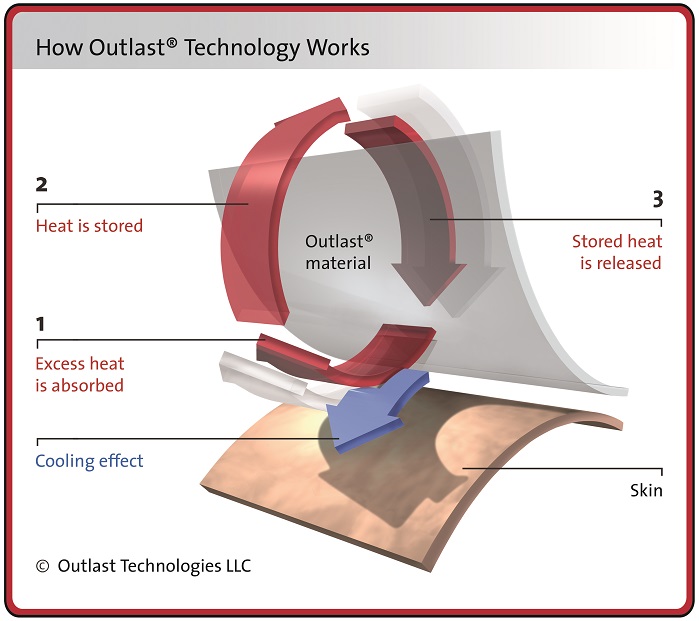
Promoting good sleep with Outlast
The Outlast technology works continuously to manage heat and moisture while reducing sweat production right from the beginning.

25th November 2015
Innovation in Textiles
|
Heidenheim
Outlast, a market leader for temperature regulating phase change materials (PCMs), has performed several tests on sleeping comfort and how PCMs can proactively influence the sleeping climate.
“We have run various tests to investigate the optimum sleeping climate. We are often asked to give evidence of the performance of our heat managing Outlast products,” explained Martin Bentz, President of Outlast Technologies LLC, Golden/USA.
“Therefore, we have looked at other test methods than climate chamber testing and have gained valuable knowledge demonstrating that the proactive nature of phase change materials positively influences sleeping comfort. Quickly, we found that temperature is not the only indicator in creating a comfortable sleeping environment.”
“An important requirement for human comfort perception is the quality of the surrounding climate. But what is comfortable? What makes sense to one may not be the same for others – some will prefer warmer environments, and some will prefer cooler. But just with humidity, there is a wide consensus that being dry is more comfortable,” explained a third party expert in Europe in the field around microclimate, Christoph Russ, the owner of the c.russNETCONSULT, Germany.
“Scientific studies on the correlation between subjective climate perception and objective climate confirm these same points. The evaluation of human comfort perception with the measurement of absolute humidity clearly outranges the one with temperature.”

Excess humidity is critical in terms of discomfort. Therefore, one important key to climate comfort is efficiently managing moisture. In general, there are two ways of optimizing the climate comfort: the reactive deduction of humidity (humidity transport) and the proactive limitation of the production of humidity.
“Once the body finds ways to reduce overheating without perspiring it will take advantage of it in order to save energy,” said Christoph Russ, who carried out testing using his testing method THG AreaView, providing a live insight into the thermoregulation of a human body.

The body reacts in a sensible way to temperature changes and normally starts sweating when it is getting too warm. Perspiration is a mechanism of the body to release excess heat and to regulate the body temperature. “The perspiration causes humidity beneath a duvet which, in spite of its intention to cool, actually increases the perception of temperature by approximately 2°C,” commented Russ.
“We call this a convective trap which is caused by a poor exchange of airflow. The individual then would need to move positions or remove the covers to create airflow - the consequence is a disturbed sleep.” An Outlast technology aims to deal with this problem by absorbing excess heat, so the body does not have to perspire to achieve cooling. The production of transpiration is already reduced, providing the additional benefit of better hygiene.
The independent test system THG SleepView, developed by Christoph Russ, makes it possible to visualize the benefits of Outlast products related to heat and moisture, and to document the numerous advantages of the smart performance material.

“We have conducted various tests with THG SleepView visually demonstrating that Outlast materials can reduce moisture significantly during the phase where you fall asleep,” said Volker Schuster, Technical Director of Outlast Europe. “As the data sensors of this new measuring system are very small they can be built directly inside the microclimate to measure the air between the skin and duvet – this is where comfort plays a role. We have found out that Outlast materials support humans in their attempt to cool down the organism during the phase of falling asleep producing more than 10% less humidity. A very good start into the night leading to an efficient improvement of comfort.”
“We found out that a duvet with an Outlast PCM fibrefill can reduce absolute humidity by 48% compared to a traditional duvet,” said Martin Bentz. “This is an impressive added value, which clearly demonstrates the proactive way our technology works. It is very important for us that our Outlast products optimize the climate inside bedding proactively – contrary to other technologies which work through humidity transport.”
The Outlast technology works continuously to manage heat and moisture while reducing sweat production right from the beginning, so less humidity is created inside the bed, the company reports. Bentz added: “Naturally, we lose up to one litre of sweat each night. Outlast materials can reduce this amount by an average of 50%.”

Business intelligence for the fibre, textiles and apparel industries: technologies, innovations, markets, investments, trade policy, sourcing, strategy...
Find out more